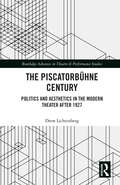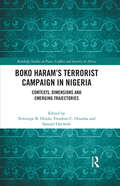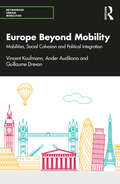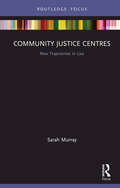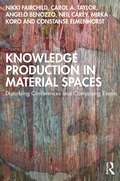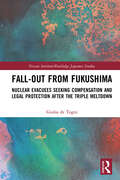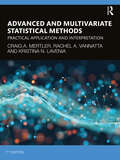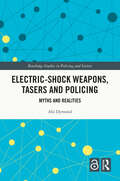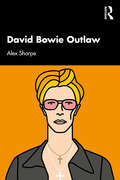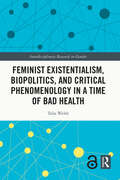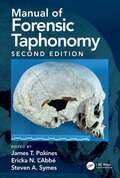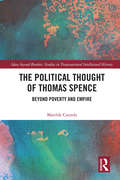- Table View
- List View
The Piscatorbühne Century: Politics and Aesthetics in the Modern Theater After 1927 (Routledge Advances in Theatre & Performance Studies)
by Drew LichtenbergThis study of the Piscatorbühne season of 1927-8 uncovers a vital, previously neglected current of radical experiment in modern theater, a ghost in the machine of contemporary performance practices. A handful of theater seasons changed the course of 20th and 21st century theatre. But only the Piscatorbühne of 1927-8 went bankrupt in less than a year. This exploration tells the story of that collapse, how it predicted the wider collapse of the late Weimar Republic, and how it relates to our own era of political polarization and economic instability. As a wider examination of Piscator’s contributions to dramaturgical and aesthetic form, ‘The Piscatorbühne Century’ makes a powerful and timely case for the renewed significance of the broader epic theater tradition. Drawing on a rich archive of interwar materials, Drew Lichtenberg reconstructs this germinal nexus of theory and praxis for the modern theatre. This book will be of great interest to students and scholars in theatre, performance, art, and literature.
Boko Haram’s Terrorist Campaign in Nigeria: Contexts, Dimensions and Emerging Trajectories (Routledge Studies in Peace, Conflict and Security in Africa)
by Temitope B. Oriola Freedom Onuoha Samuel OyewoleThis book investigates the devastating impacts of the Boko Haram terrorist campaign in Nigeria, reflecting on the group’s historical context, organizational dynamics, and emerging trajectories. Since its inception in 2002, Boko Haram’s terrorist campaign has become one of the major threats to security and human development in West Africa, killing tens of thousands of people, and displacing many more. This book reflects on the origins and development of Boko Haram, contextualizing it in the global trend of militant Islamist movements. It delves into the tactics of the organisation, their deployment of sexual and gender-based violence against women and human rights abuses in the war against them. The war against Boko Haram has seen engagement from the international community, national and regional military operations, and also a range of civilian-led movements. This book reflects on the roles of these different actors, and the emerging trajectories that need to be considered in order to eradicate Boko Haram. Drawing on a range of disciplinary perspectives, this book will be of interest to researchers across the fields of sociology, political science, African studies, and peace and conflict studies.
Boko Haram’s Terrorist Campaign in Nigeria: Contexts, Dimensions and Emerging Trajectories (Routledge Studies in Peace, Conflict and Security in Africa)
by Temitope B. OriolaThis book investigates the devastating impacts of the Boko Haram terrorist campaign in Nigeria, reflecting on the group’s historical context, organizational dynamics, and emerging trajectories. Since its inception in 2002, Boko Haram’s terrorist campaign has become one of the major threats to security and human development in West Africa, killing tens of thousands of people, and displacing many more. This book reflects on the origins and development of Boko Haram, contextualizing it in the global trend of militant Islamist movements. It delves into the tactics of the organisation, their deployment of sexual and gender-based violence against women and human rights abuses in the war against them. The war against Boko Haram has seen engagement from the international community, national and regional military operations, and also a range of civilian-led movements. This book reflects on the roles of these different actors, and the emerging trajectories that need to be considered in order to eradicate Boko Haram. Drawing on a range of disciplinary perspectives, this book will be of interest to researchers across the fields of sociology, political science, African studies, and peace and conflict studies.
Europe Beyond Mobility: Mobilities, Social Cohesion and Political Integration (Networked Urban Mobilities Series)
by Vincent Kaufmann Ander Audikana Guillaume DrevonMobility, which has represented a critical scientific category and political driver, is currently under strong public scrutiny: has mobility lost its potential for social cohesion and political integration? Europe Beyond Mobility: Mobilities, Social Cohesion and Political Integration assesses this question by focusing on the European integration process, conceptualized as a political project for the promotion of different flows of mobility. Mobility has been a fundamental tool for territorial strength and political integration among European countries. Based on a realistic understanding of the potentials and limits of mobility, this book pleads for a "resonant mobility" in the interest of a renovated European integration process. It examines how, in opposition to those advocating for national borders and mobility restrictions, the EU needs to explore new regulatory models which limit mobility’s adverse social, economic, and environmental impacts and make accessible the benefits of alternative flow models. It also provides an analytical framework for the study of current trends of mobility limitation, migration restriction and re-bordering, and offers a complementary and innovative framework for the study of globalization. Europe Beyond Mobility will be of interest to academics and students as well as policy makers and practitioners internationally in the fields of mobility, migration and border studies.
Europe Beyond Mobility: Mobilities, Social Cohesion and Political Integration (Networked Urban Mobilities Series)
by Vincent Kaufmann Ander Audikana Guillaume DrevonMobility, which has represented a critical scientific category and political driver, is currently under strong public scrutiny: has mobility lost its potential for social cohesion and political integration? Europe Beyond Mobility: Mobilities, Social Cohesion and Political Integration assesses this question by focusing on the European integration process, conceptualized as a political project for the promotion of different flows of mobility. Mobility has been a fundamental tool for territorial strength and political integration among European countries. Based on a realistic understanding of the potentials and limits of mobility, this book pleads for a "resonant mobility" in the interest of a renovated European integration process. It examines how, in opposition to those advocating for national borders and mobility restrictions, the EU needs to explore new regulatory models which limit mobility’s adverse social, economic, and environmental impacts and make accessible the benefits of alternative flow models. It also provides an analytical framework for the study of current trends of mobility limitation, migration restriction and re-bordering, and offers a complementary and innovative framework for the study of globalization. Europe Beyond Mobility will be of interest to academics and students as well as policy makers and practitioners internationally in the fields of mobility, migration and border studies.
Community Justice Centres: New Trajectories in Law (New Trajectories in Law)
by Sarah MurrayThis book examines the phenomenon of Community Justice Centres and their potential to transform the justice landscape by tackling the underlying causes of crime. Marred by recidivism, addiction, family violence, overflowing courtrooms, crippling prison spending and extreme rates of incarceration, the criminal justice system is in crisis. Community Justice Centres seek to combat this by tackling the underlying causes of crime in a particular neighbourhood and working with local people to redesign the experience of justice and enhance the notion of community. A Community Justice Centre houses a court which works with an interdisciplinary team to address the causes of criminality such as drug addiction, cognitive impairment, mental illness, poverty, abuse and intergenerational trauma. The community thus becomes a key agent of change, partnering with the Centre to tackle local issues and improve safety and community cohesion. This book, based on research into this innovative justice model, examines case studies from around the world, the challenges presented by the model and the potential for bringing its learnings into the mainstream. This book will appeal to academics in law and criminology as well as psychology; it will also be of considerable interest to people working in the criminal justice system, including the police, government policy advisers, psychologists and social workers.
Knowledge Production in Material Spaces: Disturbing Conferences and Composing Events
by Neil Carey Carol A. Taylor Nikki Fairchild Angelo Benozzo Mirka Koro Constanse ElmenhorstKnowledge Production in Material Spaces is a curation of the interventions that the authors undertook at a range of academic conferences since 2016. It problematizes disciplined practices and expectations governing academic conference spaces and generates new ways of thinking and doing conferences otherwise. The authors use posthuman, feminist materialist and post-qualitative theories to disrupt knowledge production in neoliberal and bureaucratic conferences spaces. The analysis they offer, and the rhizomatic writing and presentational styles they use, promote a form of educational activism through theory. They interrogate the conference space as a regulated, normalized and standardized mode of academic knowledge production – which they call the ‘AcademicConferenceMachine’ – and playfully subvert the dominant meanings and modes of conferences and workshops to show how we can better interact and produce research, with and for each other. The authors indicate how creative conference practices promote playful possibilities to imagine and produce knowledge differently. This book will appeal to audiences ranging from established professionals to early career scholars, doctoral and master’s students in Education and the social sciences.
Fall-out from Fukushima: Nuclear Evacuees Seeking Compensation and Legal Protection After the Triple Meltdown (Nissan Institute/Routledge Japanese Studies)
by Giulia de TogniThis book shows how the Fukushima plaintiffs have challenged narratives of safety and risk containment produced by TEPCO and the Japanese government through offering new empirical data on risk perceptions and life choices of some nuclear evacuees. Considering the Fukushima evacuees’ disappearance from public discourse in Japan, the book engages with theoretical writings on risk, neoliberal governmentality and citizen science. Chapters draw on a wide range of anthropologically-related methodologies including socio-linguistics, participant observation, and qualitative interviews. Themes of self-governance, resistance, gender, kinship, class and social change surface throughout, setting the Fukushima experience in a broad historical, social, and comparative context. This is the first ethnographic account of the Fukushima litigation and the first extensive qualitative study documenting the worldviews and living conditions of nuclear evacuees who moved outside Fukushima Prefecture, with a particular focus on underrepresented groups (single mothers, elderly and disabled evacuees). The history of industrial disasters and the role of citizens in shaping environmental policy in Japan is also evaluated. Fall-out from Fukushima sets out to be a manifesto for understanding and supporting post-nuclear disaster societies, and will appeal to students and scholars of social, legal, and linguistic anthropology, science and technology studies, as well as Japanese studies.
Community Justice Centres: New Trajectories in Law (New Trajectories in Law)
by Sarah MurrayThis book examines the phenomenon of Community Justice Centres and their potential to transform the justice landscape by tackling the underlying causes of crime. Marred by recidivism, addiction, family violence, overflowing courtrooms, crippling prison spending and extreme rates of incarceration, the criminal justice system is in crisis. Community Justice Centres seek to combat this by tackling the underlying causes of crime in a particular neighbourhood and working with local people to redesign the experience of justice and enhance the notion of community. A Community Justice Centre houses a court which works with an interdisciplinary team to address the causes of criminality such as drug addiction, cognitive impairment, mental illness, poverty, abuse and intergenerational trauma. The community thus becomes a key agent of change, partnering with the Centre to tackle local issues and improve safety and community cohesion. This book, based on research into this innovative justice model, examines case studies from around the world, the challenges presented by the model and the potential for bringing its learnings into the mainstream. This book will appeal to academics in law and criminology as well as psychology; it will also be of considerable interest to people working in the criminal justice system, including the police, government policy advisers, psychologists and social workers.
Knowledge Production in Material Spaces: Disturbing Conferences and Composing Events
by Neil Carey Carol A. Taylor Nikki Fairchild Angelo Benozzo Mirka Koro Constanse ElmenhorstKnowledge Production in Material Spaces is a curation of the interventions that the authors undertook at a range of academic conferences since 2016. It problematizes disciplined practices and expectations governing academic conference spaces and generates new ways of thinking and doing conferences otherwise. The authors use posthuman, feminist materialist and post-qualitative theories to disrupt knowledge production in neoliberal and bureaucratic conferences spaces. The analysis they offer, and the rhizomatic writing and presentational styles they use, promote a form of educational activism through theory. They interrogate the conference space as a regulated, normalized and standardized mode of academic knowledge production – which they call the ‘AcademicConferenceMachine’ – and playfully subvert the dominant meanings and modes of conferences and workshops to show how we can better interact and produce research, with and for each other. The authors indicate how creative conference practices promote playful possibilities to imagine and produce knowledge differently. This book will appeal to audiences ranging from established professionals to early career scholars, doctoral and master’s students in Education and the social sciences.
Fall-out from Fukushima: Nuclear Evacuees Seeking Compensation and Legal Protection After the Triple Meltdown (Nissan Institute/Routledge Japanese Studies)
by Giulia de TogniThis book shows how the Fukushima plaintiffs have challenged narratives of safety and risk containment produced by TEPCO and the Japanese government through offering new empirical data on risk perceptions and life choices of some nuclear evacuees. Considering the Fukushima evacuees’ disappearance from public discourse in Japan, the book engages with theoretical writings on risk, neoliberal governmentality and citizen science. Chapters draw on a wide range of anthropologically-related methodologies including socio-linguistics, participant observation, and qualitative interviews. Themes of self-governance, resistance, gender, kinship, class and social change surface throughout, setting the Fukushima experience in a broad historical, social, and comparative context. This is the first ethnographic account of the Fukushima litigation and the first extensive qualitative study documenting the worldviews and living conditions of nuclear evacuees who moved outside Fukushima Prefecture, with a particular focus on underrepresented groups (single mothers, elderly and disabled evacuees). The history of industrial disasters and the role of citizens in shaping environmental policy in Japan is also evaluated. Fall-out from Fukushima sets out to be a manifesto for understanding and supporting post-nuclear disaster societies, and will appeal to students and scholars of social, legal, and linguistic anthropology, science and technology studies, as well as Japanese studies.
Advanced and Multivariate Statistical Methods: Practical Application and Interpretation
by Craig A. Mertler Rachel A. Vannatta Kristina N. LaVeniaAdvanced and Multivariate Statistical Methods, Seventh Edition provides conceptual and practical information regarding multivariate statistical techniques to students who do not necessarily need technical and/or mathematical expertise in these methods. This text has three main purposes. The first purpose is to facilitate conceptual understanding of multivariate statistical methods by limiting the technical nature of the discussion of those concepts and focusing on their practical applications. The second purpose is to provide students with the skills necessary to interpret research articles that have employed multivariate statistical techniques. Finally, the third purpose of AMSM is to prepare graduate students to apply multivariate statistical methods to the analysis of their own quantitative data or that of their institutions. New to the Seventh Edition All references to SPSS have been updated to Version 27.0 of the software. A brief discussion of practical significance has been added to Chapter 1. New data sets have now been incorporated into the book and are used extensively in the SPSS examples. All the SPSS data sets utilized in this edition are available for download via the companion website. Additional resources on this site include several video tutorials/walk-throughs of the SPSS procedures. These "how-to" videos run approximately 5–10 minutes in length. Advanced and Multivariate Statistical Methods was written for use by students taking a multivariate statistics course as part of a graduate degree program, for example in psychology, education, sociology, criminal justice, social work, mass communication, and nursing.
Advanced and Multivariate Statistical Methods: Practical Application and Interpretation
by Craig A. Mertler Rachel A. Vannatta Kristina N. LaVeniaAdvanced and Multivariate Statistical Methods, Seventh Edition provides conceptual and practical information regarding multivariate statistical techniques to students who do not necessarily need technical and/or mathematical expertise in these methods. This text has three main purposes. The first purpose is to facilitate conceptual understanding of multivariate statistical methods by limiting the technical nature of the discussion of those concepts and focusing on their practical applications. The second purpose is to provide students with the skills necessary to interpret research articles that have employed multivariate statistical techniques. Finally, the third purpose of AMSM is to prepare graduate students to apply multivariate statistical methods to the analysis of their own quantitative data or that of their institutions. New to the Seventh Edition All references to SPSS have been updated to Version 27.0 of the software. A brief discussion of practical significance has been added to Chapter 1. New data sets have now been incorporated into the book and are used extensively in the SPSS examples. All the SPSS data sets utilized in this edition are available for download via the companion website. Additional resources on this site include several video tutorials/walk-throughs of the SPSS procedures. These "how-to" videos run approximately 5–10 minutes in length. Advanced and Multivariate Statistical Methods was written for use by students taking a multivariate statistics course as part of a graduate degree program, for example in psychology, education, sociology, criminal justice, social work, mass communication, and nursing.
New Futures for BIMSTEC: Connectivity, Commerce and Security
by Adluri Subramanyam Raju Anasua Basu Ray ChaudhuryBIMSTEC (Bay of Bengal Initiative for Multi-Sectoral Technical and Economic Cooperation) represents one of the most diverse regions of the world. Providing a unique link between South Asia and Southeast Asia, it brings together 1.5 billion people and a combined GDP of $2.7 trillion. This volume focuses on issues related to connectivity, commerce, and security challenges facing BIMSTEC. It studies BIMSTEC’s relevance as an inter-governmental organization in the changing international milieu. The volume discusses the necessity of connectivity to enhance Bay solidarity and analyses the political, strategic and security concerns that restrain commercial connectivity. It also looks at the Bay of Bengal region as a zone of competition—and possible collaboration—between the littoral countries and major powers involved in the region. Comprehensive and topical, this volume will be an essential read for scholars and researchers of international relations, South Asian studies, foreign policy, diplomacy, Southeast Asian studies, defence and strategic affairs, maritime studies, international trade, regional cooperation, and political studies.
New Futures for BIMSTEC: Connectivity, Commerce and Security
by Adluri Subramanyam Raju Anasua Basu Ray ChaudhuryBIMSTEC (Bay of Bengal Initiative for Multi-Sectoral Technical and Economic Cooperation) represents one of the most diverse regions of the world. Providing a unique link between South Asia and Southeast Asia, it brings together 1.5 billion people and a combined GDP of $2.7 trillion. This volume focuses on issues related to connectivity, commerce, and security challenges facing BIMSTEC. It studies BIMSTEC’s relevance as an inter-governmental organization in the changing international milieu. The volume discusses the necessity of connectivity to enhance Bay solidarity and analyses the political, strategic and security concerns that restrain commercial connectivity. It also looks at the Bay of Bengal region as a zone of competition—and possible collaboration—between the littoral countries and major powers involved in the region. Comprehensive and topical, this volume will be an essential read for scholars and researchers of international relations, South Asian studies, foreign policy, diplomacy, Southeast Asian studies, defence and strategic affairs, maritime studies, international trade, regional cooperation, and political studies.
Electric-Shock Weapons, Tasers and Policing: Myths and Realities (Routledge Studies in Policing and Society)
by Abi DymondBuilding on five years of research, and drawing on criminology, science and technology studies (STS), socio-legal studies and social psychology, this book is the first non-medical book written on electric-shock weapons, of which the best well known is the TASER brand. The police’s ability to use force is one of their most crucial powers, yet one that has been relatively neglected by criminology. This book challenges some of the myths surrounding the use of these weapons and considers their human rights implications and impact on members of the public and officers alike. Drawing on STS, it also considers and role and impact of electric-shock technologies, examines the extent to which technologies and non-human agency may also play a role in shaping officer decision making and discretion, and contributes to long standing debates about police accountability. This is essential reading for policing scholars around the world, particularly those engaged with use of force, culture and accountability, as well as those engaged with Science and Technology studies.
Electric-Shock Weapons, Tasers and Policing: Myths and Realities (Routledge Studies in Policing and Society)
by Abi DymondBuilding on five years of research, and drawing on criminology, science and technology studies (STS), socio-legal studies and social psychology, this book is the first non-medical book written on electric-shock weapons, of which the best well known is the TASER brand. The police’s ability to use force is one of their most crucial powers, yet one that has been relatively neglected by criminology. This book challenges some of the myths surrounding the use of these weapons and considers their human rights implications and impact on members of the public and officers alike. Drawing on STS, it also considers and role and impact of electric-shock technologies, examines the extent to which technologies and non-human agency may also play a role in shaping officer decision making and discretion, and contributes to long standing debates about police accountability. This is essential reading for policing scholars around the world, particularly those engaged with use of force, culture and accountability, as well as those engaged with Science and Technology studies.
David Bowie Outlaw: Essays on Difference, Authenticity, Ethics, Art & Love
by Alex SharpeThis book explores the relevance of David Bowie’s life and music for contemporary legal and cultural theory. Focusing on the artist and artworks of David Bowie, this book brings to life, in essay form, particular theoretical ideas, creative methodologies and ethical debates that have contemporary relevance within the fields of law, social theory, ethics and art. What unites the essays presented here is that they all point to a beyond law: to the fact that law is not enough, or to be more precise, too much, too much to bear. For those who, like Bowie, see art, creativity and love as what ought to be the central organising principles of life, law will not do. In the face of its certainties, its rigidities, and its conceits, these essays, through Bowie, call forth the monster who laughs at the law, celebrate inauthenticity as a deeper truth, explore the ethical limits of art, cut up the laws of writing and embrace that which is most antithetical to law, love. This original engagement with the limits of law will appeal to those working in legal theory, ethics and law and popular culture, as well as in art and cultural studies.
David Bowie Outlaw: Essays on Difference, Authenticity, Ethics, Art & Love
by Alex SharpeThis book explores the relevance of David Bowie’s life and music for contemporary legal and cultural theory. Focusing on the artist and artworks of David Bowie, this book brings to life, in essay form, particular theoretical ideas, creative methodologies and ethical debates that have contemporary relevance within the fields of law, social theory, ethics and art. What unites the essays presented here is that they all point to a beyond law: to the fact that law is not enough, or to be more precise, too much, too much to bear. For those who, like Bowie, see art, creativity and love as what ought to be the central organising principles of life, law will not do. In the face of its certainties, its rigidities, and its conceits, these essays, through Bowie, call forth the monster who laughs at the law, celebrate inauthenticity as a deeper truth, explore the ethical limits of art, cut up the laws of writing and embrace that which is most antithetical to law, love. This original engagement with the limits of law will appeal to those working in legal theory, ethics and law and popular culture, as well as in art and cultural studies.
Feminist Existentialism, Biopolitics, and Critical Phenomenology in a Time of Bad Health (Interdisciplinary Research in Gender)
by Talia WelshThis book explores the personal value of healthy behavior, arguing that our modern tendency to praise or blame individuals for their health is politically and economically motivated and has reinforced growing health disparities between the wealthy and poor under the guise of individual responsibility. We are awash in concerns about the state of our health and recommendations about how to improve it from medical professionals, public health experts, and the diet-exercise-wellness industry. The idea that health is about wellness and not just preventing illness becomes increasingly widespread as we find out how various modifiable behaviors, such as smoking or our diets, impact our health. In a critical examination of health, we find that alongside the move toward wellness as a state that the individual is responsible to in part produce, there is a roll-back of public programs. This book explores how this "good health imperative" is not as apolitical as one might assume. The more the individual is the locus of health, the less structural and historical issues that create health disparities are considered. Feminist Existentialism, Biopolitics, and Critical Phenomenology in a Time of Bad Health’s charts the impact of the increasing shift to a model of individual responsibility for one’s health. It will benefit readers who are interested to think critically about normalization to produce "healthy bodies." In addition, this book will benefit readers who understand the value of personal health, but are wary of the ways in which health can be used as a tool to discriminate and fuel inequalities in health care access. This volume is primarily of interest to academics, students, public health and medical professionals, and readers who are interested in critically examining health from philosophical perspective in order to understand how we can celebrate the value of healthy behavior without reinforcing discrimination.
Feminist Existentialism, Biopolitics, and Critical Phenomenology in a Time of Bad Health (Interdisciplinary Research in Gender)
by Talia WelshThis book explores the personal value of healthy behavior, arguing that our modern tendency to praise or blame individuals for their health is politically and economically motivated and has reinforced growing health disparities between the wealthy and poor under the guise of individual responsibility. We are awash in concerns about the state of our health and recommendations about how to improve it from medical professionals, public health experts, and the diet-exercise-wellness industry. The idea that health is about wellness and not just preventing illness becomes increasingly widespread as we find out how various modifiable behaviors, such as smoking or our diets, impact our health. In a critical examination of health, we find that alongside the move toward wellness as a state that the individual is responsible to in part produce, there is a roll-back of public programs. This book explores how this "good health imperative" is not as apolitical as one might assume. The more the individual is the locus of health, the less structural and historical issues that create health disparities are considered. Feminist Existentialism, Biopolitics, and Critical Phenomenology in a Time of Bad Health’s charts the impact of the increasing shift to a model of individual responsibility for one’s health. It will benefit readers who are interested to think critically about normalization to produce "healthy bodies." In addition, this book will benefit readers who understand the value of personal health, but are wary of the ways in which health can be used as a tool to discriminate and fuel inequalities in health care access. This volume is primarily of interest to academics, students, public health and medical professionals, and readers who are interested in critically examining health from philosophical perspective in order to understand how we can celebrate the value of healthy behavior without reinforcing discrimination.
Manual of Forensic Taphonomy
by James T. Pokines Ericka N. L'Abbe Steven A. SymesThe main goals in any forensic skeletal analysis are to answer who is the person represented (individualization), how that person died (trauma/pathology) and when that person died (the postmortem interval or PMI). The analyses necessary to generate the biological profile include the determination of human, nonhuman or nonosseous origin, the minimum number of individuals represented, age at death, sex, stature, ancestry, perimortem trauma, antemortem trauma, osseous pathology, odontology, and taphonomic effects—the postmortem modifications to a set of remains. The Manual of Forensic Taphonomy, Second Edition covers the fundamental principles of these postmortem changes encountered during case analysis. Taphonomic processes can be highly destructive and subtract information from bones regarding their utility in determining other aspects of the biological profile, but they also can add information regarding the entire postmortem history of the remains and the relative timing of those effects. The taphonomic analyses outlined provide guidance on how to separate natural agencies from human-caused trauma. These analyses are also performed in conjunction with the field processing of recovery scenes and the interpretation of the site formation and their postdepositional history. The individual chapters categorize these alterations to skeletal remains, illustrate and explain their significance, and demonstrate differential diagnosis among them. Such observations may then be combined into higher-order patterns to aid forensic investigators in determining what happened to those remains in the interval from death to analysis, including the environment(s) in which the remains were deposited, including buried, terrestrial surface, marine, freshwater, or cultural contexts. Features Provides nearly 300 full-color illustrations of both common and rare taphonomic effects to bones, derived from actual forensic cases • Presents new research including experimentation on recovery rates during surface search, timing of marine alterations, trophy skulls, taphonomic laboratory and field methods, laws regarding the relative timing of taphonomic effects, reptile taphonomy, human decomposition, and microscopic alterations by invertebrates to bones • Explains and illustrates common taphonomic effects and clarifies standard terminology for uniformity and usage within in the field While the book is primarily focused upon large vertebrate and specifically human skeletal remains, it effectively synthesizes data from human, ethological, geological/paleontological, paleoanthropological, archaeological artifactual, and zooarchaeological studies. Since these taphonomic processes affect other vertebrates in similar manners, The Manual of Forensic Taphonomy, Second Edition will be invaluable to a broad set of forensic and investigative disciplines.
Manual of Forensic Taphonomy
by James T. Pokines Ericka N. L’Abbé Steven A. SymesThe main goals in any forensic skeletal analysis are to answer who is the person represented (individualization), how that person died (trauma/pathology) and when that person died (the postmortem interval or PMI). The analyses necessary to generate the biological profile include the determination of human, nonhuman or nonosseous origin, the minimum number of individuals represented, age at death, sex, stature, ancestry, perimortem trauma, antemortem trauma, osseous pathology, odontology, and taphonomic effects—the postmortem modifications to a set of remains. The Manual of Forensic Taphonomy, Second Edition covers the fundamental principles of these postmortem changes encountered during case analysis. Taphonomic processes can be highly destructive and subtract information from bones regarding their utility in determining other aspects of the biological profile, but they also can add information regarding the entire postmortem history of the remains and the relative timing of those effects. The taphonomic analyses outlined provide guidance on how to separate natural agencies from human-caused trauma. These analyses are also performed in conjunction with the field processing of recovery scenes and the interpretation of the site formation and their postdepositional history. The individual chapters categorize these alterations to skeletal remains, illustrate and explain their significance, and demonstrate differential diagnosis among them. Such observations may then be combined into higher-order patterns to aid forensic investigators in determining what happened to those remains in the interval from death to analysis, including the environment(s) in which the remains were deposited, including buried, terrestrial surface, marine, freshwater, or cultural contexts. Features Provides nearly 300 full-color illustrations of both common and rare taphonomic effects to bones, derived from actual forensic cases • Presents new research including experimentation on recovery rates during surface search, timing of marine alterations, trophy skulls, taphonomic laboratory and field methods, laws regarding the relative timing of taphonomic effects, reptile taphonomy, human decomposition, and microscopic alterations by invertebrates to bones • Explains and illustrates common taphonomic effects and clarifies standard terminology for uniformity and usage within in the field While the book is primarily focused upon large vertebrate and specifically human skeletal remains, it effectively synthesizes data from human, ethological, geological/paleontological, paleoanthropological, archaeological artifactual, and zooarchaeological studies. Since these taphonomic processes affect other vertebrates in similar manners, The Manual of Forensic Taphonomy, Second Edition will be invaluable to a broad set of forensic and investigative disciplines.
The Political Thought of Thomas Spence: Beyond Poverty and Empire (Ideas beyond Borders)
by Matilde CazzolaThe book is an intellectual analysis of the political ideas of English radical thinker Thomas Spence (1750–1814), who was renowned for his "Plan", a proposal for the abolition of private landownership and the replacement of state institutions with a decentralized parochial organization. This system would be realized by means of the revolution of the "swinish multitude", the poor labouring class despised by Edmund Burke and adopted by Spence as his privileged political interlocutor. While he has long been considered an eccentric and anachronistic figure, the book sets out to demonstrate that Spence was a deeply original, thoroughly modern thinker, who translated his themes into a popular language addressing the multitude and publicized his Plan through chapbooks, tokens, and songs. The book is therefore a history of Spence's political thought "from below", designed to decode the subtle complexity of his Plan. It also shows that the Plan featured an excoriating critique of colonialism and slavery as well as a project of global emancipation. By virtue of its transnational scope, the Plan made landfall in the British West Indies a few years after Spence's death. Indeed, Spencean ideas were intellectually implicated in the largest slave revolt in the history of Barbados.
The Political Thought of Thomas Spence: Beyond Poverty and Empire (Ideas beyond Borders)
by Matilde CazzolaThe book is an intellectual analysis of the political ideas of English radical thinker Thomas Spence (1750–1814), who was renowned for his "Plan", a proposal for the abolition of private landownership and the replacement of state institutions with a decentralized parochial organization. This system would be realized by means of the revolution of the "swinish multitude", the poor labouring class despised by Edmund Burke and adopted by Spence as his privileged political interlocutor. While he has long been considered an eccentric and anachronistic figure, the book sets out to demonstrate that Spence was a deeply original, thoroughly modern thinker, who translated his themes into a popular language addressing the multitude and publicized his Plan through chapbooks, tokens, and songs. The book is therefore a history of Spence's political thought "from below", designed to decode the subtle complexity of his Plan. It also shows that the Plan featured an excoriating critique of colonialism and slavery as well as a project of global emancipation. By virtue of its transnational scope, the Plan made landfall in the British West Indies a few years after Spence's death. Indeed, Spencean ideas were intellectually implicated in the largest slave revolt in the history of Barbados.
